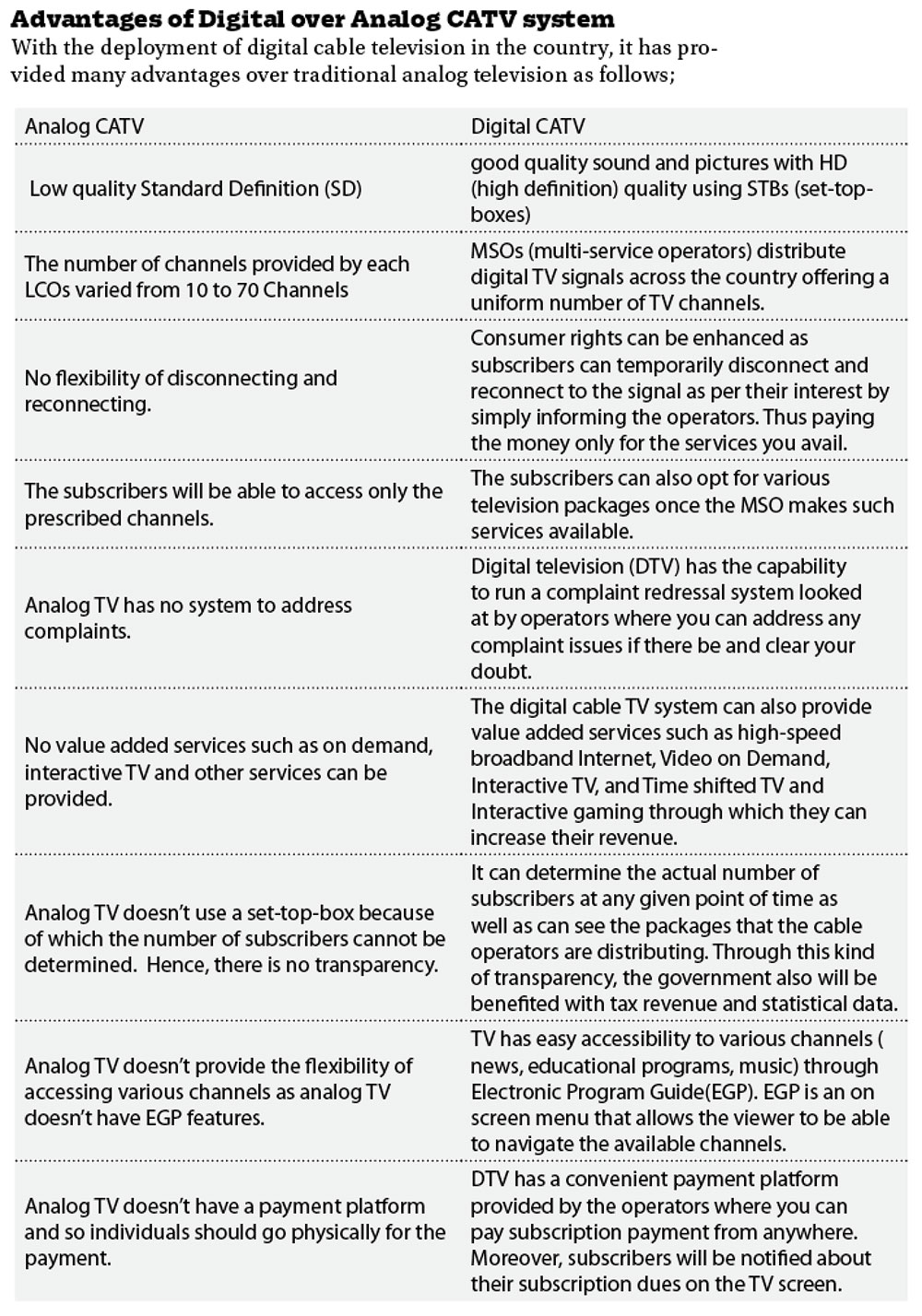In Bhutan, after using analogue television for over 16 years, the digitization of the cable television has been initiated since June, 2018 in consultation with local cable operators (LCOs) and other relevant stakeholders. The digitization was started with Thimphu and now most parts of the country have already moved towards digital connecting 60 local cable operators (LCOs) out of 93 to two Multi-Service Operators (MSOs). The digitization of cable TV was aimed to be completed by the end of year 2022. Until then, there are many issues related to the digitization process like people unwilling to switch to digital as people still do not understand the difference between the analog and digital cable television (CATV) services. There are people who are not adequately aware of the benefits of the digital and thus don’t know why Set Top Box (STB) is required and why current analog is an issue. Despite all these issues, Bhutan has moved towards providing digital TV services because of its several advantages over analog.

Difference in setting up of digital cable television from analog
Analog signal by nature is continuous and there are different types of modulation (Amplitude, Phase and Frequency modulation) in which the pattern of the carrier signal is varied according to the changing signal level of the message signal. Analog CATV systems uses vestigial sideband modulation which is a form of amplitude modulation in which one sideband is partially removed. This reduces the bandwidth of the transmitted signal, enabling narrower channels to be used. In this case, we need a coaxial cable where the signal flows and is connected directly to the TV set, requiring only one remote to control the program.
Digital TV uses quadrature amplitude modulation (QAM) techniques after compression. This gives digital modulation advantages over analog modulation with available bandwidth, high noise immunity and permissible power. This allows a television station to broadcast more channels and more HD channels over the same airwaves, giving a wider variety of programs with better quality. In this, we require additional devices like HDMI (High Definition Multimedia Interface) cable, set-top-box and remote control of the set-top-box. Coaxial cable is connected to the set-top-box and from the set-top-box, HDMI cable is connected to the TV set. Finally the program is switched using the set-top-box remote control after putting your TV into digital mode by using HDMI as source input.
Set-top-box plays an important role in digital Cable television as it allows users to view video content from specific internet video providers by decoding digital television broadcasts. It is a device that enables a TV set to receive and decode digital television (DTV) broadcasts. It is necessary for consumers who want to use their analog television sets to receive digital broadcasts.
Analogue cable TV setup
In analog television, the signal is directly received by the satellite dish which is connected to the receiver through coaxial cable. The received signal is modulated using amplitude modulation techniques which is then multiplexed and distributed to an optical transmitter where the signal is transmitted in the form of light to the receiver. On the other hand, it is also amplified and transmitted as an analog signal directly to the receiver. Modulation allows us to transmit a signal over a long distance where a high-frequency carrier wave is used to transmit the low-frequency message signal and the transmitted signal continues to have all the information contained in the original message signal.
Challenges with analog CATV system
Despite its popularity and reliability for decades, analog TV’s had a number of issues of which some of the major were:
• No innovation and has no technological up gradation in terms of offering diverse services like internet and data communications.
• Analog cable TV systems have no services like video on demand and interactive TV and games.
• Because analog is continues, signals experience interference, or signal losses and hence results in poor video quality
• Analog cable TV systems have challenges in regulating and determining the exact number of subscribers. Thereby, losing revenue to the government in terms of tax and license fees.
Hence, digitization of the CATV has become necessary to provide a better quality of services to every consumer and to both the MSOs and LCOs as well.
Digital television set up
In digital television set up, unlike analog, it uses QAM as a modulation technique where the signal gets digitized resulting in more compressed signal and better quality at the consumer side. Also with the establishment of MSOs, the requirement of head end has greatly reduced. Multiple System Operator (MSO), also known as a multi-system operator, is a designation often used for cable companies that offer services beyond television broadcast. Many MSOs offer multiple services of internet and telephone service alongside their cable television offerings. Both the MSOs are equipped with the conditional access system (CAS) and subscriber management system (SMS) in which we can determine the actual number of subscribers at any given point of time as well as customizing the type and number of channels distributed to individual subscribers. Through this digital system, there will also be transparency in the government revenue collection.
Contributed by
BICMA

